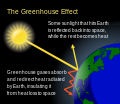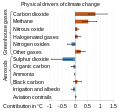The Surface Heat Budget of the Arctic Ocean (SHEBA) study was a National Science Foundation-funded research project designed to quantify the heat transfer...
10 KB (1,112 words) - 13:30, 18 June 2024
The Arctic Ocean is the smallest and shallowest of the world's five oceanic divisions. It spans an area of approximately 14,060,000 km2 (5,430,000 sq mi)...
65 KB (6,990 words) - 15:08, 12 August 2024
including Ice Station SHEBA. As part of the Surface Heat Budget of the Arctic Ocean experiment conducted in the Arctic Ocean from October 1997 to October 1998...
13 KB (1,312 words) - 11:29, 28 August 2023
ShebaMiles, Ethiopian Airlines' frequent flyer program Surface Heat Budget of the Arctic Ocean (SHEBA), an acronym for a National Science Foundation-funded...
2 KB (260 words) - 21:56, 21 December 2023
Climate change (redirect from Heating of the earth)
average surface temperature. This is because oceans lose more heat by evaporation and oceans can store a lot of heat. The thermal energy in the global...
314 KB (28,012 words) - 04:24, 26 September 2024
Antarctic/Southern, and Arctic. The ocean contains 97% of Earth's water and is the primary component of Earth's hydrosphere; thus the ocean is essential to life...
127 KB (16,965 words) - 18:02, 20 August 2024
Ocean heat content (OHC) or ocean heat uptake (OHU) is the energy absorbed and stored by oceans. To calculate the ocean heat content, it is necessary to...
48 KB (4,992 words) - 16:02, 27 September 2024
changes in the energy budget to result in any significant changes in the global surface temperature. This is due to the thermal inertia of the oceans, land...
57 KB (5,983 words) - 21:00, 12 August 2024
Institute Surface Heat Budget of the Arctic Ocean United States Arctic Research Commission University of the Arctic List of research stations in the Arctic...
2 KB (164 words) - 01:58, 10 September 2024
Cold Regions Research and Engineering Laboratory (redirect from Arctic Construction and Frost Effects Laboratory)
modeling shipping in the Northern Sea Route and the Surface Heat Budget of the Arctic Ocean (SHEBA) experiment, conducted in the Arctic Ocean from October 1997...
53 KB (4,740 words) - 15:58, 8 January 2024
Ocean acidification is the ongoing decrease in the pH of the Earth's ocean. Between 1950 and 2020, the average pH of the ocean surface fell from approximately...
142 KB (15,120 words) - 03:33, 22 September 2024
Matthew Shupe (category Explorers of the Arctic)
the following projects: 1997–1998: Surface Heat Budget of the Arctic Ocean (SHEBA) Project of the National Science Foundation, Beaufort Sea north of Alaska...
9 KB (1,012 words) - 04:05, 28 May 2024
Physical oceanography (redirect from Ocean physics)
continents. The tremendous heat capacity of the oceans moderates the planet's climate, and its absorption of various gases affects the composition of the atmosphere...
31 KB (3,737 words) - 19:27, 12 August 2024
and the 2011–2020 decade, the ocean's surface has heated between 0.68 and 1.01 °C.: 1214 The majority of ocean heat gain occurs in the Southern Ocean. For...
72 KB (13,301 words) - 08:46, 8 August 2024
MOSAiC Expedition (redirect from Multidisciplinary Drifting Observatory for the Study of Arctic Climate)
and the Association of Polar Early Career Scientists. Surface Heat Budget of the Arctic Ocean Nansen's Fram expedition Polar exploration Arctic exploration...
37 KB (4,097 words) - 09:34, 7 September 2024
Earth (redirect from Surface of the Earth)
the Solar System sustaining liquid surface water. Almost all of Earth's water is contained in its global ocean, covering 70.8% of Earth's crust. The remaining...
218 KB (19,305 words) - 16:20, 25 September 2024
Paquita Zuidema (category Fellows of the American Meteorological Society)
Environmental Technology Lab in Boulder on Surface Heat Budget of the Arctic Ocean (SHEBA) data. Arriving at the University of Miami (UM) in 2005, she worked on...
5 KB (458 words) - 15:46, 30 March 2024
Greenhouse effect (redirect from The Greenhouse effect)
Surface heating can happen from an internal heat source as in the case of Jupiter, or from its host star as in the case of the Earth. In the case of Earth...
84 KB (8,956 words) - 10:45, 25 September 2024
Thermohaline circulation (redirect from Ocean conveyer belt)
is a part of the large-scale ocean circulation that is driven by global density gradients created by surface heat and freshwater fluxes. The adjective...
25 KB (4,973 words) - 18:59, 5 July 2024
2024 in climate change (category CS1 maint: DOI inactive as of June 2024)
March (reported): the University of Maine's Climate Reanalyzer analyzed NOAA data and concluded that the average global ocean surface temperature reached...
76 KB (7,005 words) - 11:27, 26 September 2024
Europa (moon) (redirect from Oceans of Europa)
has the smoothest surface of any known solid object in the Solar System. The apparent youth and smoothness of the surface is due to a water ocean beneath...
131 KB (12,843 words) - 05:21, 17 September 2024
Carin Ashjian (category University of Rhode Island alumni)
at the Surface Heat Budget of the Arctic Ocean (SHEBA) ice camp based in the Beaufort Sea. The SHEBA mission involved freezing a ship into the ice of the...
7 KB (591 words) - 22:05, 16 July 2024
The Indian Ocean Dipole (IOD), also known as the Indian Niño, is an irregular oscillation of sea surface temperatures in which the western Indian Ocean...
20 KB (2,146 words) - 00:18, 17 July 2024
large system of circulating ocean surface currents, particularly those involved with large wind movements. Gyres are caused by the Coriolis effect; planetary...
63 KB (8,050 words) - 14:51, 28 August 2024
emissions were brought under control. Ice sheets and oceans absorb the vast majority of excess heat in the atmosphere, delaying effects there but causing them...
172 KB (19,988 words) - 23:52, 24 September 2024
Geothermal gradient (category Structure of the Earth)
mid-ocean ridges. Another major mode of heat loss is by conduction through the lithosphere, the majority of which occurs in the oceans due to the crust...
28 KB (3,157 words) - 20:09, 27 June 2024
Cryosphere (section Surface reflectance)
insulates the ground surface, and sea ice insulates the underlying ocean, decoupling the surface-atmosphere interface with respect to both heat and moisture...
28 KB (7,988 words) - 02:59, 10 August 2024
Polar amplification (redirect from Arctic amplification)
flow of ocean currents. It has been proposed that the mechanism of increased Arctic surface air temperature anomalies during La Niña periods of ENSO may...
29 KB (6,195 words) - 22:58, 23 June 2024
through the atmosphere to heat the Earth's surface. The Earth radiates it as heat, and greenhouse gases absorb a portion of it. This absorption slows the rate...
89 KB (7,974 words) - 01:57, 17 September 2024
Pierre Radisson-class icebreaker (category Ships of the Canadian Coast Guard)
research ship. The ship reentered service that year and was renamed Amundsen. As part of the Surface Heat Budget of the Arctic Ocean (SHEBA) experiment...
20 KB (1,999 words) - 08:35, 28 September 2024























